Pathophysiology and Nursing Care for a Patient with Appendicitis and Peritonitis
VerifiedAdded on 2023/06/07
|9
|2715
|490
AI Summary
This essay sheds light on the case study of Anne who is a 10 year old girl and she is has admitted to the hospital with severe right iliac fossa pain. According to the symptoms, doctors have suspected that it might be appendicitis. After appendectomy, she was diagnosed again with peritonitis, which is gangrenous in nature. Due to the infection, she had been receiving the IV antibiotic treatment. The pathophysiology of the both the diseases are discussed in this essay. Along with this, the nursing care that should be used to treat Anne had also been highlighted. The family centered care, effect of hospitalization on the Anne is also highlighted in this essay.
Contribute Materials
Your contribution can guide someone’s learning journey. Share your
documents today.
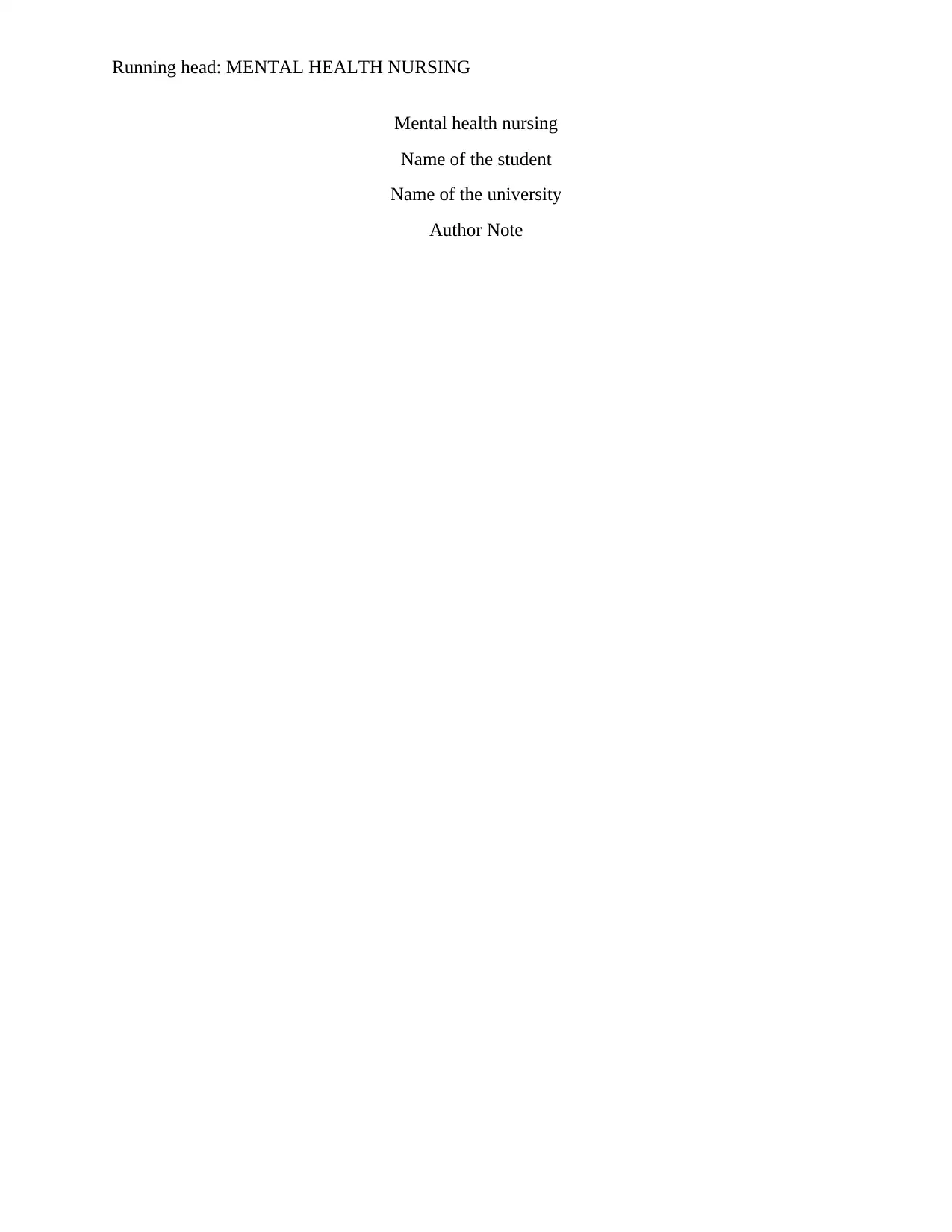
Running head: MENTAL HEALTH NURSING
Mental health nursing
Name of the student
Name of the university
Author Note
Mental health nursing
Name of the student
Name of the university
Author Note
Secure Best Marks with AI Grader
Need help grading? Try our AI Grader for instant feedback on your assignments.
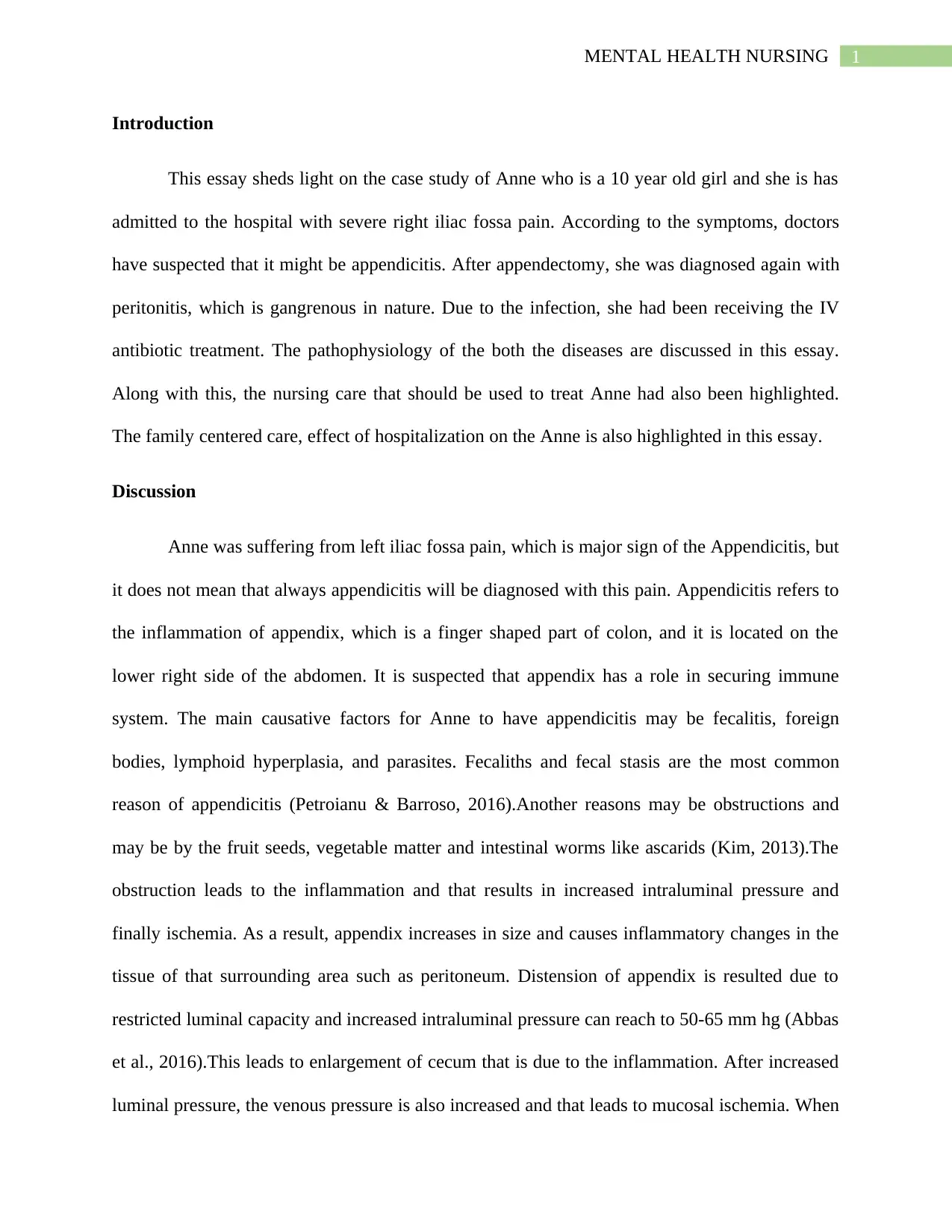
1MENTAL HEALTH NURSING
Introduction
This essay sheds light on the case study of Anne who is a 10 year old girl and she is has
admitted to the hospital with severe right iliac fossa pain. According to the symptoms, doctors
have suspected that it might be appendicitis. After appendectomy, she was diagnosed again with
peritonitis, which is gangrenous in nature. Due to the infection, she had been receiving the IV
antibiotic treatment. The pathophysiology of the both the diseases are discussed in this essay.
Along with this, the nursing care that should be used to treat Anne had also been highlighted.
The family centered care, effect of hospitalization on the Anne is also highlighted in this essay.
Discussion
Anne was suffering from left iliac fossa pain, which is major sign of the Appendicitis, but
it does not mean that always appendicitis will be diagnosed with this pain. Appendicitis refers to
the inflammation of appendix, which is a finger shaped part of colon, and it is located on the
lower right side of the abdomen. It is suspected that appendix has a role in securing immune
system. The main causative factors for Anne to have appendicitis may be fecalitis, foreign
bodies, lymphoid hyperplasia, and parasites. Fecaliths and fecal stasis are the most common
reason of appendicitis (Petroianu & Barroso, 2016).Another reasons may be obstructions and
may be by the fruit seeds, vegetable matter and intestinal worms like ascarids (Kim, 2013).The
obstruction leads to the inflammation and that results in increased intraluminal pressure and
finally ischemia. As a result, appendix increases in size and causes inflammatory changes in the
tissue of that surrounding area such as peritoneum. Distension of appendix is resulted due to
restricted luminal capacity and increased intraluminal pressure can reach to 50-65 mm hg (Abbas
et al., 2016).This leads to enlargement of cecum that is due to the inflammation. After increased
luminal pressure, the venous pressure is also increased and that leads to mucosal ischemia. When
Introduction
This essay sheds light on the case study of Anne who is a 10 year old girl and she is has
admitted to the hospital with severe right iliac fossa pain. According to the symptoms, doctors
have suspected that it might be appendicitis. After appendectomy, she was diagnosed again with
peritonitis, which is gangrenous in nature. Due to the infection, she had been receiving the IV
antibiotic treatment. The pathophysiology of the both the diseases are discussed in this essay.
Along with this, the nursing care that should be used to treat Anne had also been highlighted.
The family centered care, effect of hospitalization on the Anne is also highlighted in this essay.
Discussion
Anne was suffering from left iliac fossa pain, which is major sign of the Appendicitis, but
it does not mean that always appendicitis will be diagnosed with this pain. Appendicitis refers to
the inflammation of appendix, which is a finger shaped part of colon, and it is located on the
lower right side of the abdomen. It is suspected that appendix has a role in securing immune
system. The main causative factors for Anne to have appendicitis may be fecalitis, foreign
bodies, lymphoid hyperplasia, and parasites. Fecaliths and fecal stasis are the most common
reason of appendicitis (Petroianu & Barroso, 2016).Another reasons may be obstructions and
may be by the fruit seeds, vegetable matter and intestinal worms like ascarids (Kim, 2013).The
obstruction leads to the inflammation and that results in increased intraluminal pressure and
finally ischemia. As a result, appendix increases in size and causes inflammatory changes in the
tissue of that surrounding area such as peritoneum. Distension of appendix is resulted due to
restricted luminal capacity and increased intraluminal pressure can reach to 50-65 mm hg (Abbas
et al., 2016).This leads to enlargement of cecum that is due to the inflammation. After increased
luminal pressure, the venous pressure is also increased and that leads to mucosal ischemia. When

2MENTAL HEALTH NURSING
the luminal pressure exceeds the value of 85mm hg ,the venous and lymphatic drainages are
altered and causes ischemia to develop (Narci et al.,2013).The bacteria that may involve in
Anne’s disease, are E.coli,Enterococcus, Pseudomonas (Zhong et al.,2014).The obstruction in
appendiceal lumen is a crucial cause of Anne’s gangrenous appendix (Ishizuka, Shimizu,&
Kubota,2013).However the obstruction may be developed due to inflammation. The resulted
inflammation stretches in to the peritoneum, serosa and other nearby organs. This results in the
stimulation of visceral afferent nerve fiber that take entry into the spinal cord at T8-T10 region.
In this case, if the situation is neglected, arterial blood flow is altered and causes infarction. This
infarction results in gangrene and perforation of organ in Anne after the appendectomy. In
appendicitis, the inflammation is supported by the expression of IL-6 and TNF-alpha. The
increased level of TF production and decreased level of tissue factor pathway inhibitor are
responsible for the gangrenous appendicitis. On the other hand, the peritonitis refers to the
inflammated condition of peritoneum due to the medical condition Anne have. In this case study
Anne have diagnosed with peritonitis due to the ruptured appendix. The peritonitis is associated
with the increased amount of tumor necrosis factors, proinflammatory cytokines, IL-1, and
interpheron gamma. In response to an inflammation, the cytokines are produced by the
macrophages (Impellizzeri et al., 2013).In this condition, cytokines are directly transferred to the
intestinal barrier. Another important factor that is associated with the perforated appendicitis is
the increased level of serotonin and it is mainly associated with the inflammation of the tissue.
The release of serotonin causes hike in intraluminal pressure and vasoconstriction and that
ultimately results in inflammation ( de Lambert et al.,2016). Ultimately, it can be concluded that
the blockage in appendicular artery and veins are responsible for the gangrene and perforation of
the organ and ultimately results in peritonitis (Drake et al., 2014).
the luminal pressure exceeds the value of 85mm hg ,the venous and lymphatic drainages are
altered and causes ischemia to develop (Narci et al.,2013).The bacteria that may involve in
Anne’s disease, are E.coli,Enterococcus, Pseudomonas (Zhong et al.,2014).The obstruction in
appendiceal lumen is a crucial cause of Anne’s gangrenous appendix (Ishizuka, Shimizu,&
Kubota,2013).However the obstruction may be developed due to inflammation. The resulted
inflammation stretches in to the peritoneum, serosa and other nearby organs. This results in the
stimulation of visceral afferent nerve fiber that take entry into the spinal cord at T8-T10 region.
In this case, if the situation is neglected, arterial blood flow is altered and causes infarction. This
infarction results in gangrene and perforation of organ in Anne after the appendectomy. In
appendicitis, the inflammation is supported by the expression of IL-6 and TNF-alpha. The
increased level of TF production and decreased level of tissue factor pathway inhibitor are
responsible for the gangrenous appendicitis. On the other hand, the peritonitis refers to the
inflammated condition of peritoneum due to the medical condition Anne have. In this case study
Anne have diagnosed with peritonitis due to the ruptured appendix. The peritonitis is associated
with the increased amount of tumor necrosis factors, proinflammatory cytokines, IL-1, and
interpheron gamma. In response to an inflammation, the cytokines are produced by the
macrophages (Impellizzeri et al., 2013).In this condition, cytokines are directly transferred to the
intestinal barrier. Another important factor that is associated with the perforated appendicitis is
the increased level of serotonin and it is mainly associated with the inflammation of the tissue.
The release of serotonin causes hike in intraluminal pressure and vasoconstriction and that
ultimately results in inflammation ( de Lambert et al.,2016). Ultimately, it can be concluded that
the blockage in appendicular artery and veins are responsible for the gangrene and perforation of
the organ and ultimately results in peritonitis (Drake et al., 2014).

3MENTAL HEALTH NURSING
It has been found that the nursing care needs an appropriate training, which should be
implemented in the practice of their respective work. According to Ball et al. (2013), this
involves the growth and the developmental practice in the nursing care, which can be obtained
by a nurse in their training period. This would help a nurse in practicing the work throughout the
career. This growth and the development of the nursing training would help the nurse to build up
the sense of the cognitive perspective.
According to Piaget’s theory, Anne is in the concrete developmental stage, she is
developing her cognition power. Development of organized, logical thinking will help Anne to
understand the condition of her own, and that helps in reducing anxiety in Anne. The abolition of
egocentric behavior allows Anne to be more mature as she is the oldest among the five children.
She can also participate in nursing of her siblings, as her parents are not at home for their
occupation (Mischel, 2013). According to the theory of development by Erickson, Anne is in the
stage of facing the task of industry vs. inferiority. In this stage, Anne may develop the feeling of
inferiority to their siblings. At this stage, Anne should be encouraged for her initiative so that she
can gain confidence in attaining her goal. However, Anne’s parents are unable to stay at home
due to their profession. This results in growing of inferiority issues in Anne and lowers Anne’s
self-confidence. Moreover, lack in attaining special skills will also promote Anne’s inferiority
sense. Although Anne started to develop the adulthood, it is not the right time to discuss with her
about her medication (McLeod, 2013). The term family centered care refers to the practice of
nursing that allows the mutually beneficial relationship between the patients, patient is family
and the nurse. According to this the family members of Anne have a crucial role in maintaining
Anne’s health and as well as wellbeing of Anne (Carter et al.,2014).The medication related
consents are mostly related to the family of Anne and it is because of the minority of Anne. Anne
It has been found that the nursing care needs an appropriate training, which should be
implemented in the practice of their respective work. According to Ball et al. (2013), this
involves the growth and the developmental practice in the nursing care, which can be obtained
by a nurse in their training period. This would help a nurse in practicing the work throughout the
career. This growth and the development of the nursing training would help the nurse to build up
the sense of the cognitive perspective.
According to Piaget’s theory, Anne is in the concrete developmental stage, she is
developing her cognition power. Development of organized, logical thinking will help Anne to
understand the condition of her own, and that helps in reducing anxiety in Anne. The abolition of
egocentric behavior allows Anne to be more mature as she is the oldest among the five children.
She can also participate in nursing of her siblings, as her parents are not at home for their
occupation (Mischel, 2013). According to the theory of development by Erickson, Anne is in the
stage of facing the task of industry vs. inferiority. In this stage, Anne may develop the feeling of
inferiority to their siblings. At this stage, Anne should be encouraged for her initiative so that she
can gain confidence in attaining her goal. However, Anne’s parents are unable to stay at home
due to their profession. This results in growing of inferiority issues in Anne and lowers Anne’s
self-confidence. Moreover, lack in attaining special skills will also promote Anne’s inferiority
sense. Although Anne started to develop the adulthood, it is not the right time to discuss with her
about her medication (McLeod, 2013). The term family centered care refers to the practice of
nursing that allows the mutually beneficial relationship between the patients, patient is family
and the nurse. According to this the family members of Anne have a crucial role in maintaining
Anne’s health and as well as wellbeing of Anne (Carter et al.,2014).The medication related
consents are mostly related to the family of Anne and it is because of the minority of Anne. Anne
Secure Best Marks with AI Grader
Need help grading? Try our AI Grader for instant feedback on your assignments.

4MENTAL HEALTH NURSING
was not capable of taking decisions about herself. In this scenario, the family of Anne is directly
involved. It is very important to involve the family centered care in caring of Anne. The
hospitalization of Anne is very much stressful to her family and as well as to her extended
family. After appendectomy, again, she was diagnosed with the peritonitis and this would
definitely increase the level of stress on their family member. In case of Anne, the open
communication with the family members of Anne improves the quality of nursing care for Anne.
The nursing personnel shares all the information with Anne’s family and these encourages the
family members in participating in the medication process which includes the privacy rights and
consent issues (Toomey, et al., 2015). The understanding between the family members and the
nursing personnel allows the family member to act as Anne’s committee, advisor and as well as
task force for promoting the best medication outcome. A well-maintained supportive
environment helps the family member or the siblings of Anne to take part in safety committees,
increasing quality of services and in decision-making. To implement this model properly
pediatric nurses provide a few control to the family member of Anne and the nurses drives
family members in protecting and taking care of Anne (Coyne, 2015). Cultural safety is another
crucial factor for pediatric and neonatal nursing personnel in implementing family centered
model in Anne’s care (James, Nelson & Ashwill, 2014). It is very important to honor and respect
different cultural practices in order to provide a proper family centered care. The members who
are from different cultures can help the other members to understand that particular culture so
that he or she can give proper care to the patient. After identifying Anne’s culture the pediatric
nurse should try to correlate the cultural view with her own in order to contribute in Anne’s
medication. Family centered patient care will help Anne to recover as soon as possible from the
painful condition. So it can be said that family centered care is an effective process in nursing
was not capable of taking decisions about herself. In this scenario, the family of Anne is directly
involved. It is very important to involve the family centered care in caring of Anne. The
hospitalization of Anne is very much stressful to her family and as well as to her extended
family. After appendectomy, again, she was diagnosed with the peritonitis and this would
definitely increase the level of stress on their family member. In case of Anne, the open
communication with the family members of Anne improves the quality of nursing care for Anne.
The nursing personnel shares all the information with Anne’s family and these encourages the
family members in participating in the medication process which includes the privacy rights and
consent issues (Toomey, et al., 2015). The understanding between the family members and the
nursing personnel allows the family member to act as Anne’s committee, advisor and as well as
task force for promoting the best medication outcome. A well-maintained supportive
environment helps the family member or the siblings of Anne to take part in safety committees,
increasing quality of services and in decision-making. To implement this model properly
pediatric nurses provide a few control to the family member of Anne and the nurses drives
family members in protecting and taking care of Anne (Coyne, 2015). Cultural safety is another
crucial factor for pediatric and neonatal nursing personnel in implementing family centered
model in Anne’s care (James, Nelson & Ashwill, 2014). It is very important to honor and respect
different cultural practices in order to provide a proper family centered care. The members who
are from different cultures can help the other members to understand that particular culture so
that he or she can give proper care to the patient. After identifying Anne’s culture the pediatric
nurse should try to correlate the cultural view with her own in order to contribute in Anne’s
medication. Family centered patient care will help Anne to recover as soon as possible from the
painful condition. So it can be said that family centered care is an effective process in nursing
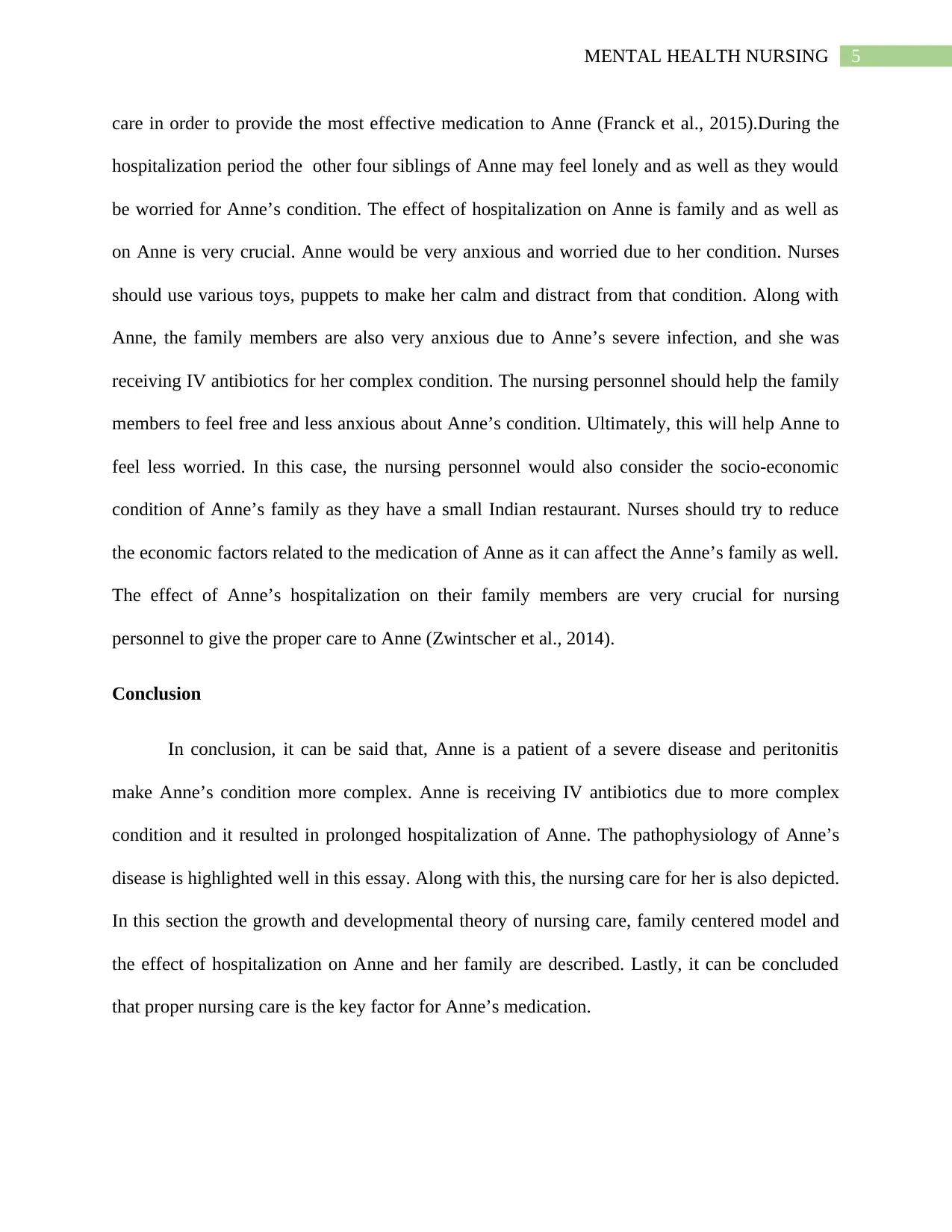
5MENTAL HEALTH NURSING
care in order to provide the most effective medication to Anne (Franck et al., 2015).During the
hospitalization period the other four siblings of Anne may feel lonely and as well as they would
be worried for Anne’s condition. The effect of hospitalization on Anne is family and as well as
on Anne is very crucial. Anne would be very anxious and worried due to her condition. Nurses
should use various toys, puppets to make her calm and distract from that condition. Along with
Anne, the family members are also very anxious due to Anne’s severe infection, and she was
receiving IV antibiotics for her complex condition. The nursing personnel should help the family
members to feel free and less anxious about Anne’s condition. Ultimately, this will help Anne to
feel less worried. In this case, the nursing personnel would also consider the socio-economic
condition of Anne’s family as they have a small Indian restaurant. Nurses should try to reduce
the economic factors related to the medication of Anne as it can affect the Anne’s family as well.
The effect of Anne’s hospitalization on their family members are very crucial for nursing
personnel to give the proper care to Anne (Zwintscher et al., 2014).
Conclusion
In conclusion, it can be said that, Anne is a patient of a severe disease and peritonitis
make Anne’s condition more complex. Anne is receiving IV antibiotics due to more complex
condition and it resulted in prolonged hospitalization of Anne. The pathophysiology of Anne’s
disease is highlighted well in this essay. Along with this, the nursing care for her is also depicted.
In this section the growth and developmental theory of nursing care, family centered model and
the effect of hospitalization on Anne and her family are described. Lastly, it can be concluded
that proper nursing care is the key factor for Anne’s medication.
care in order to provide the most effective medication to Anne (Franck et al., 2015).During the
hospitalization period the other four siblings of Anne may feel lonely and as well as they would
be worried for Anne’s condition. The effect of hospitalization on Anne is family and as well as
on Anne is very crucial. Anne would be very anxious and worried due to her condition. Nurses
should use various toys, puppets to make her calm and distract from that condition. Along with
Anne, the family members are also very anxious due to Anne’s severe infection, and she was
receiving IV antibiotics for her complex condition. The nursing personnel should help the family
members to feel free and less anxious about Anne’s condition. Ultimately, this will help Anne to
feel less worried. In this case, the nursing personnel would also consider the socio-economic
condition of Anne’s family as they have a small Indian restaurant. Nurses should try to reduce
the economic factors related to the medication of Anne as it can affect the Anne’s family as well.
The effect of Anne’s hospitalization on their family members are very crucial for nursing
personnel to give the proper care to Anne (Zwintscher et al., 2014).
Conclusion
In conclusion, it can be said that, Anne is a patient of a severe disease and peritonitis
make Anne’s condition more complex. Anne is receiving IV antibiotics due to more complex
condition and it resulted in prolonged hospitalization of Anne. The pathophysiology of Anne’s
disease is highlighted well in this essay. Along with this, the nursing care for her is also depicted.
In this section the growth and developmental theory of nursing care, family centered model and
the effect of hospitalization on Anne and her family are described. Lastly, it can be concluded
that proper nursing care is the key factor for Anne’s medication.
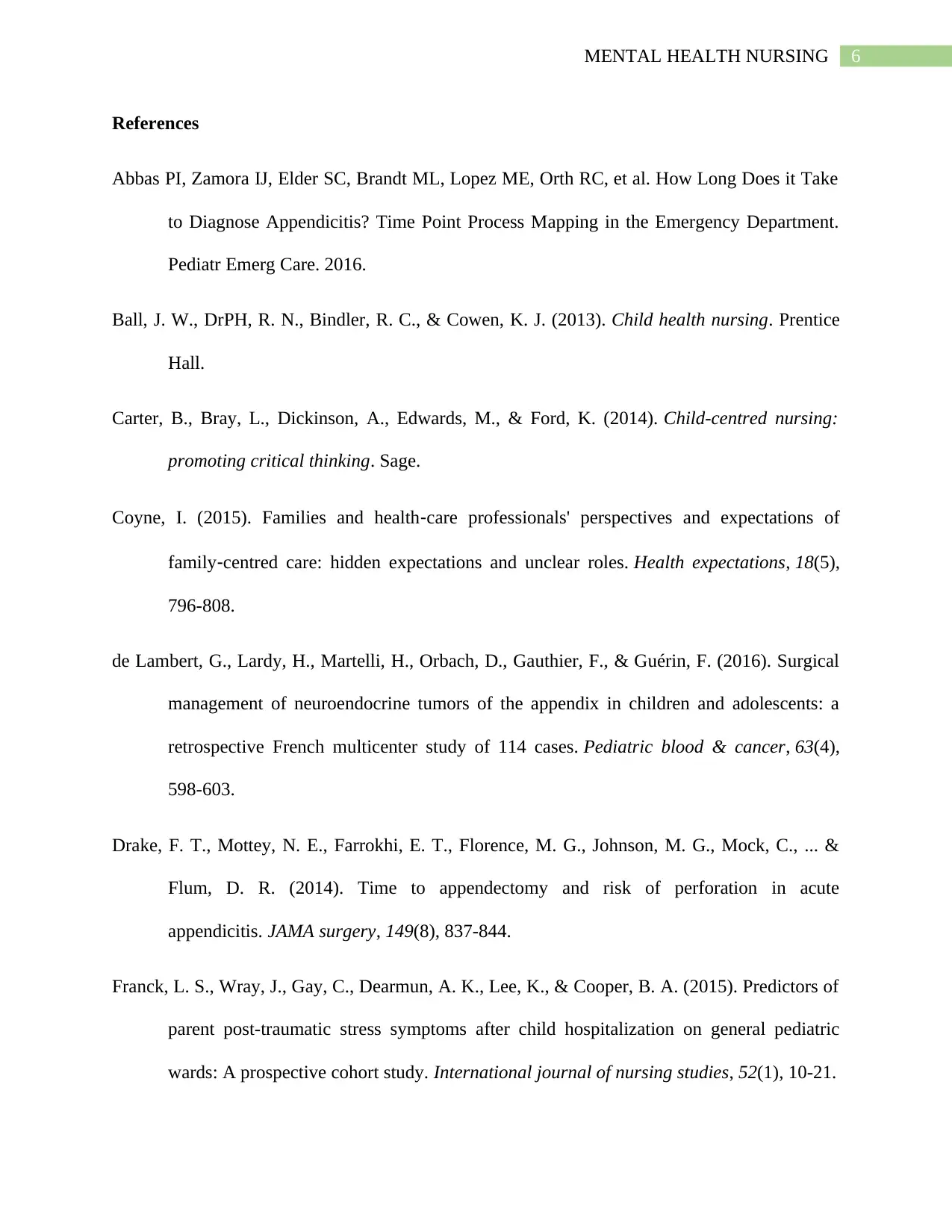
6MENTAL HEALTH NURSING
References
Abbas PI, Zamora IJ, Elder SC, Brandt ML, Lopez ME, Orth RC, et al. How Long Does it Take
to Diagnose Appendicitis? Time Point Process Mapping in the Emergency Department.
Pediatr Emerg Care. 2016.
Ball, J. W., DrPH, R. N., Bindler, R. C., & Cowen, K. J. (2013). Child health nursing. Prentice
Hall.
Carter, B., Bray, L., Dickinson, A., Edwards, M., & Ford, K. (2014). Child-centred nursing:
promoting critical thinking. Sage.
Coyne, I. (2015). Families and health‐care professionals' perspectives and expectations of
family‐centred care: hidden expectations and unclear roles. Health expectations, 18(5),
796-808.
de Lambert, G., Lardy, H., Martelli, H., Orbach, D., Gauthier, F., & Guérin, F. (2016). Surgical
management of neuroendocrine tumors of the appendix in children and adolescents: a
retrospective French multicenter study of 114 cases. Pediatric blood & cancer, 63(4),
598-603.
Drake, F. T., Mottey, N. E., Farrokhi, E. T., Florence, M. G., Johnson, M. G., Mock, C., ... &
Flum, D. R. (2014). Time to appendectomy and risk of perforation in acute
appendicitis. JAMA surgery, 149(8), 837-844.
Franck, L. S., Wray, J., Gay, C., Dearmun, A. K., Lee, K., & Cooper, B. A. (2015). Predictors of
parent post-traumatic stress symptoms after child hospitalization on general pediatric
wards: A prospective cohort study. International journal of nursing studies, 52(1), 10-21.
References
Abbas PI, Zamora IJ, Elder SC, Brandt ML, Lopez ME, Orth RC, et al. How Long Does it Take
to Diagnose Appendicitis? Time Point Process Mapping in the Emergency Department.
Pediatr Emerg Care. 2016.
Ball, J. W., DrPH, R. N., Bindler, R. C., & Cowen, K. J. (2013). Child health nursing. Prentice
Hall.
Carter, B., Bray, L., Dickinson, A., Edwards, M., & Ford, K. (2014). Child-centred nursing:
promoting critical thinking. Sage.
Coyne, I. (2015). Families and health‐care professionals' perspectives and expectations of
family‐centred care: hidden expectations and unclear roles. Health expectations, 18(5),
796-808.
de Lambert, G., Lardy, H., Martelli, H., Orbach, D., Gauthier, F., & Guérin, F. (2016). Surgical
management of neuroendocrine tumors of the appendix in children and adolescents: a
retrospective French multicenter study of 114 cases. Pediatric blood & cancer, 63(4),
598-603.
Drake, F. T., Mottey, N. E., Farrokhi, E. T., Florence, M. G., Johnson, M. G., Mock, C., ... &
Flum, D. R. (2014). Time to appendectomy and risk of perforation in acute
appendicitis. JAMA surgery, 149(8), 837-844.
Franck, L. S., Wray, J., Gay, C., Dearmun, A. K., Lee, K., & Cooper, B. A. (2015). Predictors of
parent post-traumatic stress symptoms after child hospitalization on general pediatric
wards: A prospective cohort study. International journal of nursing studies, 52(1), 10-21.
Paraphrase This Document
Need a fresh take? Get an instant paraphrase of this document with our AI Paraphraser
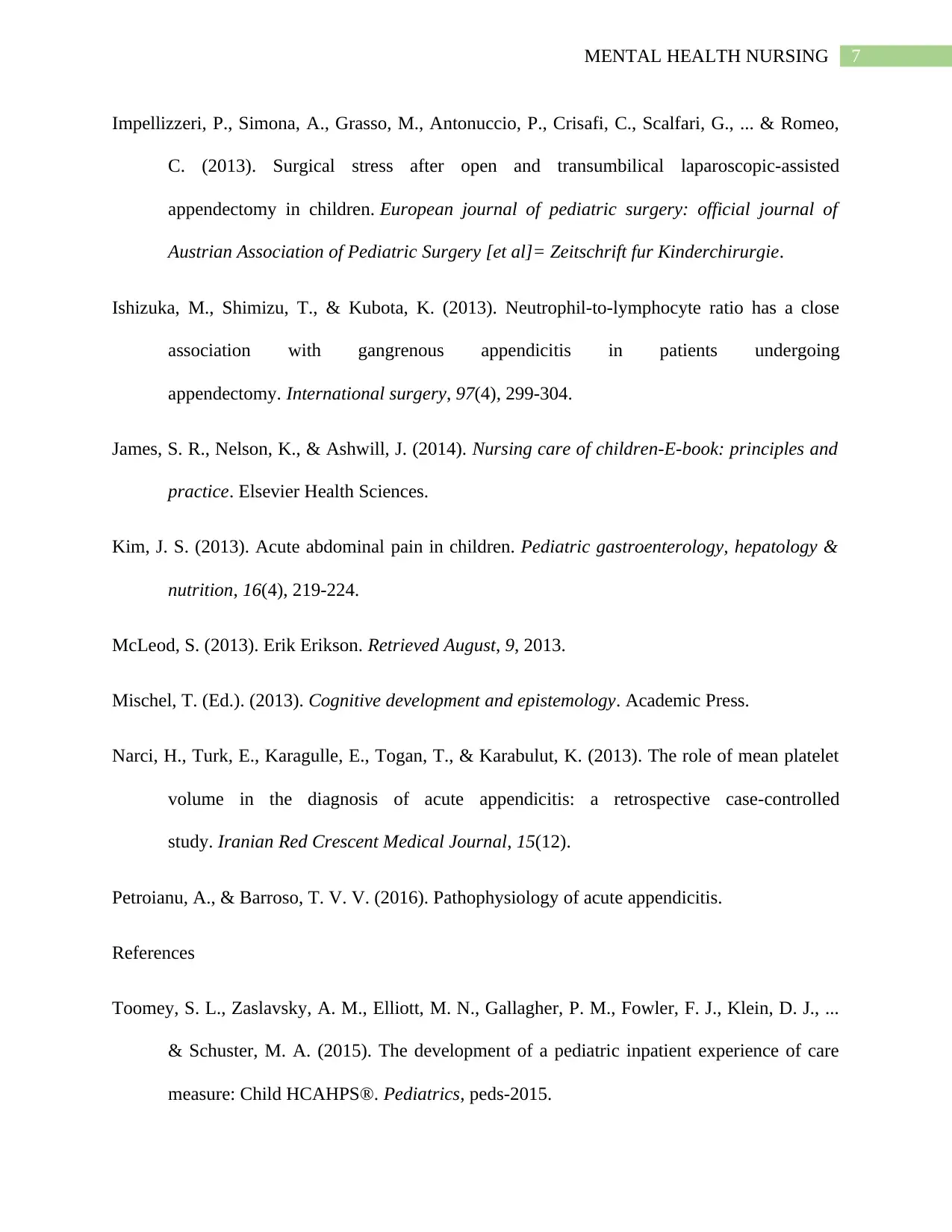
7MENTAL HEALTH NURSING
Impellizzeri, P., Simona, A., Grasso, M., Antonuccio, P., Crisafi, C., Scalfari, G., ... & Romeo,
C. (2013). Surgical stress after open and transumbilical laparoscopic-assisted
appendectomy in children. European journal of pediatric surgery: official journal of
Austrian Association of Pediatric Surgery [et al]= Zeitschrift fur Kinderchirurgie.
Ishizuka, M., Shimizu, T., & Kubota, K. (2013). Neutrophil-to-lymphocyte ratio has a close
association with gangrenous appendicitis in patients undergoing
appendectomy. International surgery, 97(4), 299-304.
James, S. R., Nelson, K., & Ashwill, J. (2014). Nursing care of children-E-book: principles and
practice. Elsevier Health Sciences.
Kim, J. S. (2013). Acute abdominal pain in children. Pediatric gastroenterology, hepatology &
nutrition, 16(4), 219-224.
McLeod, S. (2013). Erik Erikson. Retrieved August, 9, 2013.
Mischel, T. (Ed.). (2013). Cognitive development and epistemology. Academic Press.
Narci, H., Turk, E., Karagulle, E., Togan, T., & Karabulut, K. (2013). The role of mean platelet
volume in the diagnosis of acute appendicitis: a retrospective case-controlled
study. Iranian Red Crescent Medical Journal, 15(12).
Petroianu, A., & Barroso, T. V. V. (2016). Pathophysiology of acute appendicitis.
References
Toomey, S. L., Zaslavsky, A. M., Elliott, M. N., Gallagher, P. M., Fowler, F. J., Klein, D. J., ...
& Schuster, M. A. (2015). The development of a pediatric inpatient experience of care
measure: Child HCAHPS®. Pediatrics, peds-2015.
Impellizzeri, P., Simona, A., Grasso, M., Antonuccio, P., Crisafi, C., Scalfari, G., ... & Romeo,
C. (2013). Surgical stress after open and transumbilical laparoscopic-assisted
appendectomy in children. European journal of pediatric surgery: official journal of
Austrian Association of Pediatric Surgery [et al]= Zeitschrift fur Kinderchirurgie.
Ishizuka, M., Shimizu, T., & Kubota, K. (2013). Neutrophil-to-lymphocyte ratio has a close
association with gangrenous appendicitis in patients undergoing
appendectomy. International surgery, 97(4), 299-304.
James, S. R., Nelson, K., & Ashwill, J. (2014). Nursing care of children-E-book: principles and
practice. Elsevier Health Sciences.
Kim, J. S. (2013). Acute abdominal pain in children. Pediatric gastroenterology, hepatology &
nutrition, 16(4), 219-224.
McLeod, S. (2013). Erik Erikson. Retrieved August, 9, 2013.
Mischel, T. (Ed.). (2013). Cognitive development and epistemology. Academic Press.
Narci, H., Turk, E., Karagulle, E., Togan, T., & Karabulut, K. (2013). The role of mean platelet
volume in the diagnosis of acute appendicitis: a retrospective case-controlled
study. Iranian Red Crescent Medical Journal, 15(12).
Petroianu, A., & Barroso, T. V. V. (2016). Pathophysiology of acute appendicitis.
References
Toomey, S. L., Zaslavsky, A. M., Elliott, M. N., Gallagher, P. M., Fowler, F. J., Klein, D. J., ...
& Schuster, M. A. (2015). The development of a pediatric inpatient experience of care
measure: Child HCAHPS®. Pediatrics, peds-2015.
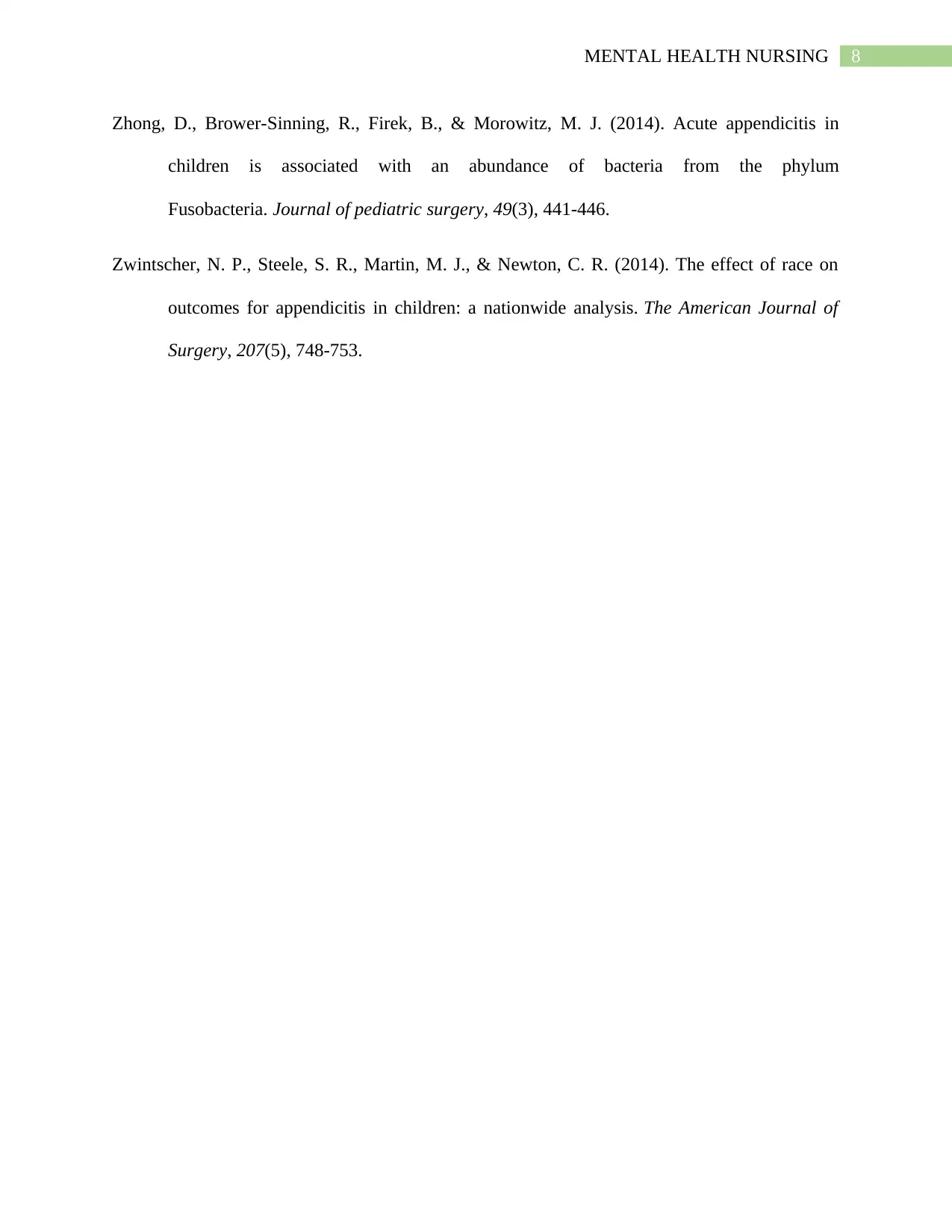
8MENTAL HEALTH NURSING
Zhong, D., Brower-Sinning, R., Firek, B., & Morowitz, M. J. (2014). Acute appendicitis in
children is associated with an abundance of bacteria from the phylum
Fusobacteria. Journal of pediatric surgery, 49(3), 441-446.
Zwintscher, N. P., Steele, S. R., Martin, M. J., & Newton, C. R. (2014). The effect of race on
outcomes for appendicitis in children: a nationwide analysis. The American Journal of
Surgery, 207(5), 748-753.
Zhong, D., Brower-Sinning, R., Firek, B., & Morowitz, M. J. (2014). Acute appendicitis in
children is associated with an abundance of bacteria from the phylum
Fusobacteria. Journal of pediatric surgery, 49(3), 441-446.
Zwintscher, N. P., Steele, S. R., Martin, M. J., & Newton, C. R. (2014). The effect of race on
outcomes for appendicitis in children: a nationwide analysis. The American Journal of
Surgery, 207(5), 748-753.
1 out of 9
Related Documents
Your All-in-One AI-Powered Toolkit for Academic Success.
+13062052269
info@desklib.com
Available 24*7 on WhatsApp / Email
![[object Object]](/_next/static/media/star-bottom.7253800d.svg)
Unlock your academic potential
© 2024 | Zucol Services PVT LTD | All rights reserved.





